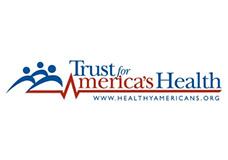![]()
![]()
![]()
![]()
![]()
![]()
 After three decades of increases, adult obesity rates remained level in every state except for one, Arkansas, in the past year, according to F as in Fat: How Obesity Threatens America’s Future 2013 , a report from the Trust for America’s Health (TFAH) and the Robert Wood Johnson Foundation (RWJF).
After three decades of increases, adult obesity rates remained level in every state except for one, Arkansas, in the past year, according to F as in Fat: How Obesity Threatens America’s Future 2013 , a report from the Trust for America’s Health (TFAH) and the Robert Wood Johnson Foundation (RWJF).
Thirteen states now have adult obesity rates above 30 percent, 41 states have rates of at least 25 percent, and every state is above 20 percent, according to the report. In 1980, no state was above 15 percent; in 1991, no state was above 20 percent; in 2000, no state was above 25 percent; and, in 2007, only Mississippi was above 30 percent.*
Since 2005, there has been some evidence that the rate of increase has been slowing. In 2005, every state but one experienced an increase in obesity rates; in 2008, rates increased in 37 states; in 2010, rates increased in 28 states; and in 2011, rates increased in 16 states.*
“While stable rates of adult obesity may signal prevention efforts are starting to yield some results, the rates remain extremely high,” said Jeffrey Levi, Ph.D., executive director of TFAH. “Even if the nation holds steady at the current rates, Baby Boomers—who are aging into obesity-related illnesses—and the rapidly rising numbers of extremely obese Americans are already translating into a cost crisis for the healthcare system and Medicare.”
Levi added, “In order to decrease obesity and related costs, we must ensure that policies at every level support healthy choices, and we must focus investments on prevention.”
Key findings from the 2013 F as in Fat report include:
Rates vary by region. Of the states with the 20 highest adult obesity rates, only Pennsylvania is not in the South or Midwest. For the first time in eight years, Mississippi no longer has the highest rate—Louisiana at 34.7 percent is the highest, followed closely by Mississippi at 34.6 percent. Colorado had the lowest rate at 20.5 percent. Rates vary by age. Obesity rates for Baby Boomers (45-to 64-year-olds)** have reached 40 percent in two states (Alabama and Louisiana) and are 30 percent or higher in 41 states. By comparison, obesity rates for seniors (65+ years old) exceed 30 percent in only one state (Louisiana). Obesity rates for young adults (18-to 25-year-olds) are below 28 percent in every state. Rates by gender are now consistent . Ten years ago, there was nearly a 6 percentage point difference between rates for men and women (men: 27.5 percent, women: 33.4 percent), and now rates are nearly the same (men: 35.8 percent, women 35.5 percent). Men’s obesity rates have been climbing faster than women’s for this last decade. Rates of “extreme” obesity have grown dramatically . Rates of adult Americans with a body mass index (BMI) of 40 or higher have grown in the past 30 years from 1.4 percent to 6.3 percent—a 350 percent increase. Among children and teens (2-to 19-year-olds), more than 5.1 percent of males and 4.7 percent of females are now severely obese. Rates vary by education . More than 35 percent of adults ages 26 and older who did not graduate high school are obese, compared with 21.3 percent of those who graduated from college or technical college. Rates vary by income. More than 31 percent of adults ages 18 and older who earn less than $25,000 per year were obese, compared with 25.4 percent of those who earn at least $50,000 per year. In addition to the latest data showing a stable rate for adult obesity, a new report released by the Centers for Disease Control and Prevention (CDC) earlier this month shows 18 states and one U.S. territory experienced a decline in obesity rates among preschool children from low-income families. The report provides state-specific trends in obesity rates among children ages 2 to 4 who are enrolled in federal health and nutrition programs, such as the Special Nutrition Program for Women, Infants, and Children (WIC).
“After decades of unrelenting bad news, we’re finally seeing signs of progress. In addition to today’s news about the steady rates for adults, we’ve seen childhood obesity rates declining in cities and states that were among the first to adopt a comprehensive approach to obesity prevention,” said Risa Lavizzo-Mourey, MD, RWJF president and CEO. “But no one should believe the nation’s work is done. We’ve learned a lot in the last decade about how to prevent obesity. Now it’s time to take that knowledge to scale.”
F as in Fat features a series examining high-impact policies to prevent and reduce obesity in the United States. The series highlights significant policy accomplishments over the past decade, including: historic changes to nutrition standards for school foods; improved health screenings for children; changes to improve nutrition and health counseling in the WIC program; increased understanding about how the built environment affects our ability to eat healthy foods and be physically active; the growth of a “complete streets” movement; the launch of a Prevention and Public Health Fund and National Prevention Strategy; and a growth in community-based programs for obesity and related illnesses.
The report includes a growing set of strategies that have improved health– but stresses that they are not yet implemented or funded at a level to reduce obesity trends significantly. Some key recommendations from the report regarding strategies that should be taken to scale include:
All food in schools must be healthy; Kids and adults should have access to more opportunities to be physically active on a regular basis; Restaurants should post calorie information on menus; Food and beverage companies should market only their healthiest products to children; The country should invest more in preventing disease to save money on treating it; America’s transportation plans should encourage walking and biking; and Everyone should be able to purchase healthy, affordable foods close to home. The full report with state rankings in all categories and new interactive maps are available at fasinfat.org . TFAH and RWJF collaborated on the report, which was supported by a grant from RWJF.
2012 STATE-BY-STATE ADULT OBESITY RATES
According to recently released CDC data, part of the 2012 Behavioral Risk Factor Surveillance Survey, adult obesity rates by state from highest to lowest were:
Note: 1 = Highest rate of adult obesity, 51 = lowest rate of adult obesity.
1. Louisiana (34.7%); 2. Mississippi (34.6%) 3. Arkansas (34.5%); 4. West Virginia (33.8%); 5. Alabama (33%); 6. Oklahoma (32.2%); 7. South Carolina (31.6%); 8. Indiana (31.4%); 9. Kentucky (31.3%); 10. (tie) Michigan and Tennessee (31.1%); 12. Iowa (30.4%); 13. Ohio (30.1%); 14. Kansas (29.9%); 15. (tie) North Dakota and Wisconsin (29.7%); 17. (tie) Missouri and North Carolina (29.6%); 19. Texas (29.2%); 20. (tie) Georgia and Pennsylvania (29.1%); 22. Nebraska (28.6%); 23. Maine (28.4%); 24. (tie) Illinois and South Dakota (28.1%); 26. Maryland (27.6%); 27. Virginia (27.4%); 28. (tie) New Hampshire and Oregon (27.3%); 30. New Mexico (27.1%); 31. Delaware (26.9%); 32. (tie) Idaho and Washington (26.8%); 34. Nevada (26.2%); 35. Arizona (26%); 36. (tie) Alaska and Minnesota and Rhode Island (25.7%); 39. Connecticut (25.6%); 40. Florida (25.2%); 41. California (25%); 42. (tie) New Jersey and Wyoming (24.6%); 44. (tie) Montana and Utah (24.3%); 46. Vermont (23.7%); 47. (tie) Hawaii and New York (23.6%); 49. Massachusetts (22.9%); 50. District of Columbia (21.9%); 51. Colorado (20.5%).
2012 STATE-BY-STATE ADULT OBESITY RANKINGS FOR BABY BOOMERS
** (45-64 Year Olds, includes most Baby Boomers, who range from 49-67 year olds)
Note: 1 = Highest rate of adult obesity, 51 = lowest rate of adult obesity.
1. (tie) Alabama and Louisiana (40.0%); 3. Arkansas (38.9%); 4. Mississippi (38.5%); 5. Tennessee (38.2%); 6. West Virginia (37.8%); 7. Indiana (37.0%); 8. Missouri (36.9%); 9. South Carolina (36.8%); 10. Oklahoma (36.7%); 11. Kentucky (36.0%); 12. Iowa (35.9%); 13. Wisconsin (35.4%); 14. North Dakota (35.0%); 15. Texas (34.9%); 16. Ohio (34.8%); 17. North Carolina (34.7%); 18. Georgia (34.6%); 19. Nebraska (34.5%); 20 (tie) Maryland and Michigan (34.4%); 22. Kansas (34.3%); 23. Virginia (34.2%); 24. Illinois (33.6%); 25. Delaware (33.5%); 26. Pennsylvania (33.2%); 27. South Dakota (32.9%); 28. Maine (32.5%); 29. Alaska (32.4%); 30. Utah (32.3%); 31. Idaho (32.1%); 32. Oregon (32.0%); 33. District of Columbia (31.9%); 34. (tie) New Hampshire and Washington (31.3%); 36. Nevada (31.1%); 37. California (31.0%); 38. Florida (30.7%); 39. (tie) New Mexico and Rhode Island (30.2%); 41. Minnesota (30.0%); 42. Wyoming (29.4%); 43. Montana (29.1%); 44. Arizona (28.9%); 45. Connecticut (28.4%); 46. New York (27.6%); 47. Massachusetts (27.5%); 48. New Jersey (27.3%); 49. Hawaii (26.8%); 50. Vermont (26.4%); 51. Colorado (24.6%).






